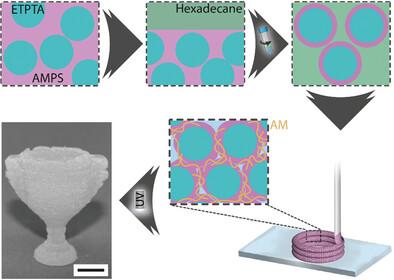刚性微颗粒的直接墨水写入
IF 13
2区 材料科学
Q1 CHEMISTRY, MULTIDISCIPLINARY
引用次数: 0
摘要
直接墨水写入(DIW)可实现具有明确结构和成分的宏观物体的三维打印,这些结构和成分可在 100 微米的长度范围内可控变化。遗憾的是,由于直接墨水写入技术对墨水的流变性有严格要求,因此只能对有限的材料进行处理。对于软质材料来说,如果将其配制成微颗粒,即使堵塞也能满足印刷的流变学要求,那么就能克服这一限制。相比之下,刚度超过 2 兆帕的致密硬质微粒则无法表现出适当的流变特性,无法实现 DIW。这里介绍的是一种由高达 60 Vol% 的刚性微颗粒组成的油墨,其核心刚度高达 50 MPa。为了实现这一目标,我们制作了具有软水凝胶外壳的刚性微颗粒。通过在软壳和间隙中形成第 2 层网络,3D 打印出的脆弱颗粒结构转变为承重颗粒材料。这些颗粒可打印成复杂的三维结构,如奖杯,或浇铸成灵活的宏观光子薄膜。本文章由计算机程序翻译,如有差异,请以英文原文为准。

Direct Ink Writing of Rigid Microparticles
Direct ink writing (DIW) enables 3D printing of macroscopic objects with well-defined structures and compositions that controllably change over length scales of order 100 µm. Unfortunately, only a limited number of materials can be processed through DIW because it imparts stringent rheological requirements on inks. This limitation can be overcome for soft materials, if they are formulated as microparticles that, if jammed, fulfill the rheological requirements to be printed. By contrast, densely packed rigid microparticles with stiffnesses exceeding 2 MPa do not exhibit appropriate rheological properties that enable DIW. Here, an ink composed of up to 60 vol% rigid microparticles with core stiffnesses up to 50 MPa is introduced. To achieve this goal, rigid microparticles possessing soft hydrogel shells are produced. The 3D printed fragile granular structure is transformed into a load-bearing granular material through the formation of a 2nd network within the soft shells and in the interstitial spaces. The potential of these particles is demonstrated to be printed into intricate 3D structures, such as a trophy cup, or cast into flexible macroscopic photonic films.
求助全文
通过发布文献求助,成功后即可免费获取论文全文。
去求助
来源期刊

Small
工程技术-材料科学:综合
CiteScore
17.70
自引率
3.80%
发文量
1830
审稿时长
2.1 months
期刊介绍:
Small serves as an exceptional platform for both experimental and theoretical studies in fundamental and applied interdisciplinary research at the nano- and microscale. The journal offers a compelling mix of peer-reviewed Research Articles, Reviews, Perspectives, and Comments.
With a remarkable 2022 Journal Impact Factor of 13.3 (Journal Citation Reports from Clarivate Analytics, 2023), Small remains among the top multidisciplinary journals, covering a wide range of topics at the interface of materials science, chemistry, physics, engineering, medicine, and biology.
Small's readership includes biochemists, biologists, biomedical scientists, chemists, engineers, information technologists, materials scientists, physicists, and theoreticians alike.
 求助内容:
求助内容: 应助结果提醒方式:
应助结果提醒方式:


